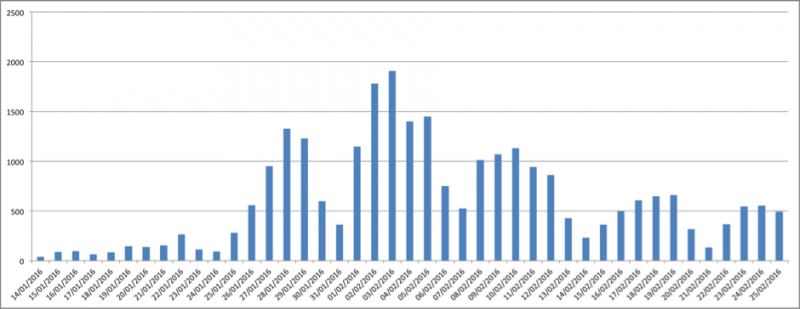Frankenflies sent to defeat Zika

A coalition of the willing has unleashed a surge of Frankenflies at the frontline of the War on Zika. Armed with a genetic payload, the airborne troops will carry out a precision strike against a rogue group of Mozzys that harbor the virus. Proponents argue by clearing the ground of hostile flies they will be able to degrade the operating capability of virus and neutralize the threat of the current Zika insurgency in Brazil and beyond. However, critics claim this shock and awe approach will prove ineffective in the face of Mozzy guerilla tactics, with flies able to go to ground through reliance on egg dumps hidden in native territory. Further there are concerns that despite advances in precision molecular bombing, this nuclear option could result in collateral damage; or at worst further de-stabilize the situation, allowing an axis of airborne pathogens to invade the territory, potentially leading to the emergence of new, more dangerous weapons of mass infection.
When gene drives go to war
Public opinion is shaped by the way science is communicated. The metaphors that we choose can have a powerful role in this process, with the ability to inspire or to horrify, to enlighten or to confuse. Synthetic Biology is saturated with metaphors, and as an emerging field dealing with controversial issues such as gene editing, practitioners face a difficult task in getting it right.
A couple of weeks ago we [Steven Burgess, Carmen McLeod and Brigitte Nerlich] sat down together to discuss working on a post for the PLOS Synbio Community blog. We wanted to write something about the way gene drives are described, as is one of the more controversial topics in synthetic biology. Because our meeting was at the height of media attention to the spread of the Zika virus across Southern America, particularly Brazil, we thought it might be a good idea to look at what people were saying about gene drives in the context of Zika.
Brigitte then did one of her quick trawls through 'All English Language News' on the Nexis news database – more about that later – and was surprised to find that the metaphor of war was a major framing device when talking about gene drives in the context of Zika. Brigitte was corresponding with Kate Roach, a Frankenstein specialist, who suggested some nice spoof headlines, one of which we used for this post. Steven then wrote our spoof first paragraph, which summarises the essence of some of the Zika/biotech discourse that one can find 'out there' and we were off!

In the following we'll provide a bit of background to Zika and gene drives, then home in on the war metaphors we found, before discussing some of their social, ethical and political implications.
Zika
The Zika virus was first identified in monkeys in Uganda in 1947 – rhesus monkeys that lived in a forest called Zika. It gradually spread from Africa to Central America. The virus is carried by the Aedes aegypti mosquito which has also been linked to transmitting dengue fever, yellow fever and chikungunya. In May 2015 the Zika spreading mosquitoes reached Brazil, where the virus, which until then only caused mild discomfort, is suspected to be linked to a large cluster of microcephaly cases (evidence is getting stronger) and has, more recently been linked to Guillain-Barré syndrome too. It has now been discovered that the virus can be transmitted sexually and even through saliva. The mosquitoes that transmit the virus through their bite are female and thrive in urban surroundings in particular, especially in pools of stagnant water.
There are many options to deal with the virus and its vector – the mosquito -, from citizen science and on the ground activities like spraying pesticides and eliminating pools of stagnant water, to experimental genetic modification of mosquitoes (making males sterile or even inducing sex change from female to male), to more futuristic interventions that could wipe out the insect population as a whole – through the use of a technology called 'gene drive'.
GM, gene editing and gene drives
A 'gene drive' is a recent development in biotechnology. Although the concept has been around for a while, it is an advanced application of genetic modification based on an existing genome editing tool, called CRISPR-Cas9, that allows scientists to precisely insert, replace, delete or regulate genes in many different species. A gene drive enables a quick and persistent spread of a genetic trait within a population of a particular organism. This is especially feasible in organisms with a short generation time, and gene drives are only effective in sexually reproducing organisms. However, as the government response to the report on genetically modified insects by the House of Lords Science and Technology Select Committee has pointed out: "With gene-drive technology still at a relatively early stage of development, it is likely to be some years before any proposal may be forthcoming for a field release of a gene-drive insect." (p. 4)
In the context of dealing with dengue fever, some GM insects have been developed in particular by the British firm Oxitec, now part of the US company Intrexon. The insects are genetically modified to be sterile, but don't contain a gene-drive. The language used on Oxitec's website to describe the technology makes for interesting reading.
Oxitec

The GM insects are described as machines that include switches, have machinery and can go into overdrive. But they are not just machines – they are lethal machines. Initially developed to 'fight' dengue fever in Brazil, this technology is now becoming part of the 'arsenal' deployed against Zika's 'explosive' spread.
When a virus goes viral
In the English media Zika seems to have been discussed since the 1990s, but especially around 2007, when people began to monitor its worldwide spread. At the end of 2015 possible links with microcephaly were noticed and Brazil declared a public health emergency on 11 November 2015. Our graph starts on 15 January 2016, when the US Centers for Disease Control issued a travel alert. On 28 January the World Health Organization (WHO) talked about an 'explosive spread', and and in a twitter message Brazilian President Dilma Rousseff declared war on mosquitoes responsible for spreading the Zika virus (first peak in our graph). On 1 February the WHO declared a public health emergency of international concern and sexual transmission of Zika is beginning to be discussed (leading to the highest peak in our graph). On 10 February strong evidence links Zika to microcephaly (third peak in our graph). On 16 February the WHO announced that it supported research into the use of GM mosquitoes as tools control the Zika outbreak.
War metaphors
In order to get a very quick and dirty insight into how gene drives are being discussed in the context of the Zika outbreak, we accessed the Nexis database and searched All English Language News with the search terms 'Zika' AND 'gene drive'. This retrieved 58 articles. Of these 21 were online articles (of which 3 were duplicates) and 35 mainstream media articles (of which 15 were duplicates and two not relevant). This provided us with a very small but manageable window on press coverage regarding Zika and gene drives. But, of course, more research needs to be done.
When going through the small corpus of articles, we found to our surprise that in the context of the Zika 'threat' GM insects and also gene drives were almost exclusively discussed through the lens of war not science – or rather science becomes a weapon in the war on Zika. In particular, gene drives and GM insects were seen as 'potent weapons' or 'powerful tools', 'GM weaponry', 'means of attack', a 'powerful biotech weapon', or a new tool in the existing 'arsenal'/'artillery' that could be used to 'wipe out' the insects/virus (indeed, 'wipe it off the face of the earth'), 'knock down' the virus, and, of course 'fight' and 'combat' the virus, 'stop it in its tracks' and 'kill' the insects. Gene drives were discussed as a potent 'extinction option' that could be used to launch 'a final blow' against a 'wily foe' that 'spreads bioterror in its wake'. Some even talked about a program of 'Total Mosquito Destruction' and a 'nuclear option'.
Three articles in particular used a range of war metaphors. One was written by Daniel Engber for Slate Magazine (29 January). In this article Engber wants to 'give'm hell' and commit 'mass mosquito-cide'. Another more moderate article was written by Michael Reilly for MIT's online Technology Review (29 January) and contains both verbal and visual war imagery. The third article, by Archie Bland for the Guardian (10 February), initially talks not only about 'wiping out' the 'bloodsuckers' but also about 'editing nature' (quoting scientists, it should be stressed).
However, this article also quoted other voices that contributed to a more nuanced reflection on the issue. The journalist then wonders (referring not to gene drives but GM insects): "All the same, there is a certain bitter irony that in an attempt to beat a disease whose impact will be felt most keenly by women and their unborn children, and which has been exacerbated by a shortage of funding for studies that would focus on the wellbeing of women in developing countries, we are contemplating a macho solution that entails sending male mosquitoes to impregnate as many females as possible, with the ultimate ambition of wiping the enemy off the face of the Earth."
Three more articles contributed to a more critical debate on GM insects and on the potential use of gene drives. One important article was written quite early on by Kevin M. Esvelt which appeared both online and in the mainstream media on 26/27 January and called for responsibility, transparency and collective scrutiny. He also points out: "Nowadays, there are few opportunities for public input until after products are developed, when it is typically too late to make changes. By ignoring potentially helpful contributions from an increasingly knowledgeable public, closed-door technological development has precluded balanced assessments and created acrimony—a dangerously irresponsible and wasteful outcome for both science and society." An appeal to responsible innovation!
Another article for the online magazine Gizmodo by George Dvorsky had the misleading title "It's time to declare war on mosquitoes" (7 February). Dvorsky argues that just fighting war against Zika is misguided. Instead Dvorsky uses the metaphor of 'Brazilian Jiu-Jitsu' – i.e. we have to fight clever so to speak and mix effective population control measures 'with the latest that genomic technologies have to offer' – including gene drives. Dvorsky quotes Esvelt as telling Gizmodo: "Gene drive offers a way of altering, reducing, or even eliminating these deadly mosquitoes in the wild by ensuring that genomic changes are preferentially inherited by offspring," .. "CRISPR gene drives capable of affecting the worst offenders are nearly within our reach." However, as Dvorsky says, there are other options too and it's worth reading the whole article to get familiar with some of them.
Finally, an article by the risk specialist Andrew Maynard, uses, like Dvorsky's one, a range of war metaphors (arsenal, combat etc.). However, it is one of the rare ones that talk about 'synthetic biology', throws in some synbio metaphors (italicised) and still talks about responsible use of new technologies in a messy context, namely biology: "Yet we still have only the vaguest ideas of how the systems we're hacking actually work. It's as if we've been given free rein to play with life's operating system code, but unlike computers, we don't have the luxury of rebooting when things go wrong. This is not an argument against using synthetic biology to combat Zika and other infectious diseases – far from it. If developed responsibly, the technology could save millions of lives, and improve living conditions for countless more. It does mean, though, that we have to be exceptionally cautious in how we proceed – and take every ounce of advice and insight we can get on how to weigh the potential risks and consequences of what we do. "
Although the word gene drive as such doesn't evoke war and combat, in the context of Zika it began to attract such connotations, as there was ample talk about driving down the insect population, driving it out, as well as of course driving genetic modification through a whole population. There is also talk about eradication, extinction and, of course, control.
Metaphors matter
Sending in GM insects and deploying gene drives as the ultimate weapon in the war against Zika is, as one article pointed out, part of a 'macho' solution, a solution that focuses on a technofix focused on killing the insects/virus. This militaristic, command and control, frame sidelines a number of issues which are discussed in a few articles, such as responsibility, transparency and public scrutiny. More importantly though, looking at Zika through a militaristic lens, blends out a whole lot of social, political and ethical issues related to poverty, inequality and gender. This has implications for social, public and health policy, but also for health, risk and science communication. Communication within a command and control context is very different to communication within an engaged community context.
Military metaphors are commonplace in medicine and 'explode' in particular during epidemics or pandemics like AIDS, foot and mouth disease, SARS, and most recently Ebola. As Cooter pointed out many years ago in a chapter on 'War and modern medicine' (1994), "each of our 'illnesses' must be fought (usually with the help of magic bullets, which we sometimes receive in the form of shots); that we battle AIDS by seeking the means to restore defence systems), is but small testimony to the profundity and reach of the process. 'Biomilitarism', as one discourse analyst has labelled it, is now the language of modern biomedicine."
Modern advances in biotechnology and biomedicine, including gene editing and gene drives, still get caught up in this archaic but persistent, pervasive militaristic framing, a framing that has ethical, social and political consequences for those living with Zika. We have to be careful. If you frame a disaster, crisis or epidemic like a war, it gradually becomes a war; with winners (probably Oxitec/Intrexon) and with losers, victims, casualties and collateral damage (probably women and children).
Although martial in tone, the 'Brazilian Jiu-Jitsu' metaphor was actually an effective means of highlighting the need for a balanced approach. As the case of gene drives demonstrate, the metaphors we use in synthetic biology can have wide-ranging impacts on society, and this will only be amplified as scientists seek to take the tools they have developed into the world.
Provided by Public Library of Science
This story is republished courtesy of PLOS Blogs: blogs.plos.org.


















